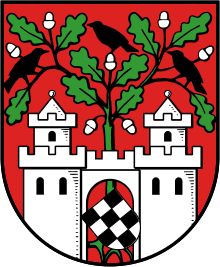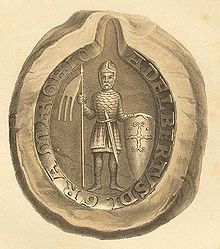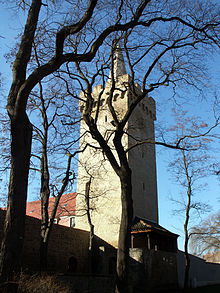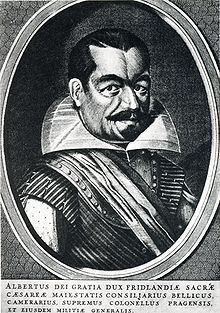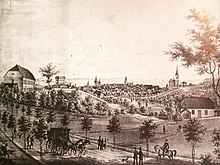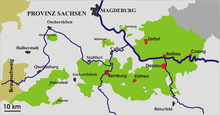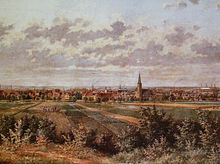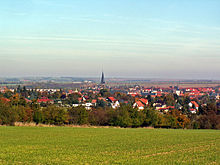History of the city of Aschersleben
The history of the city of Aschersleben in the northern Harz foreland spans more than 1250 years since the city was first mentioned and can also be traced back to the prehistoric settlement areas.
Early history
The climatically favorable location in the rain shadow of the Harz already attracted people to the area where Aschersleben is today. The Einetal, which emerges from the Vorharz here, and the very fertile soil played an important role in the early settlement of the area.
The oldest finds from a hunting camp come from the Bruchsberg near Königsaue, about five kilometers from the city of Aschersleben, and date from more than 55,800 years ago. The Aschersleber Lake , which until it was drained at the time of Frederick the Great, largely existed as a twelve-kilometer-long flat lake , was repeatedly visited by hunters and gatherers on its shores . Numerous finds of flat and humped graves as well as grave goods from the Neolithic confirm this.
At the time of the Great Migration , the warning settled in the area. There is evidence of a farming settlement from the 6th century. Locations with the ending Leben indicate this. The name Aschersleben is made up of the personal name Asceger ( Escherner Wurfspeer ger = spear) and -leben ( lev = heritage). Aschersleben is accordingly interpreted as the legacy of the gunmen or spearmen.
First mention
In 753 a place in Thuringia called Ascegereslebe was first mentioned in the Codex Eberhardi compiled in the middle of the 12th century . The source was a gift from the Passau choir bishop Madalwin (died after 903), who transferred his property in Aschersleben “including the serfs” to St. Boniface ( Fulda Monastery ). However, the mention of Aschersleben does not follow a temporal but a geographical order and is therefore located at the geographically determined location where the donation was made. Due to the lack of a date, the assumption arose that that first mention could also fall in the 9th century. The mention of Aschershausen in the course of the 748 devastated villages in the dispute between Pippin and his half-brother Grifo speaks for a mention in the 8th century . This document, which reports on the devastation, was subsequently issued by the Marburg historian Prof. Dr. Edmund Ernst Stengel dated 1960 to the third quarter of the 9th century, which means that Aschersleben was first mentioned around the years 850 to 875.
Time of the Ascanians
In the 11th century, the city passed into the possession of the Ascanians , whose name comes from Ascania or Ascharia , the Latinized form of the city of Aschersleben. Albrecht the Bear was at the head of the Ascanians. He went down in German history with the conquest of the Nordmark and the Mark Brandenburg and is considered the founder of the House of Anhalt . Under Albrecht the Bear, Aschersleben became the center of the administrative and judicial district ruled by the Ascanians. Sources of the time tell of numerous dishes in and around Aschersleben. The gravescap to aschersleve is mentioned in the medieval legal book Sachsenspiegel .
The fact that Aschersleben's own coins were put into circulation for the first time shows that Aschersleben was of particular importance to Albrecht the Bear. Around 1860 numerous bracteates were found near Freckleben that show the portrait of Albrecht the Bear. These bracteates and denarii were the first Anhalt coins. In 1120 the construction of the Askanierburg began. The location of the castle is still controversial today, but the location in Aschersleben is probably where it is today, on Burgplatz . It is worth mentioning the slaughter of Udo von Freckleben in 1130 by the followers of Albrecht the Bear during a feud . When Albrecht the Bear probably died in Stendal on November 18, 1170 , the Ascanians were among the most important families of princes in the Holy Roman Empire . He left behind a large area of rulership that included the county of Aschersleben, Brandenburg, Saxony-Wittenberg, Saxony-Lauenburg and parts of Thuringia.
The area was now taken over by five of his seven sons. There was an inheritance division within the Ascanian house . His youngest son Bernhard III. (1140-1212) received the Ascanian possessions east of the Saale and, after the early death of his brother Adalbert in 1171, also the Ballenstedt area. Bernhard founded the Ascanian county of Aschersleben within the Principality of Anhalt in the 12th century , after which the city became the county seat, administrative and court location.
In the period that followed, the Ascanians repeatedly clashed with their great rivals, the Guelphs , especially in the dispute over the Duchy of Saxony . The Guelphs under Heinrich the Lion not only destroyed Anhalt Castle in the Selke Valley in 1140 , but also devastated Aschersleben in 1142 and 1175. After the death of his father, Bernhard III., In 1212, the land was divided between the two sons of the deceased, as is customary with the Ascanians: Heinrich I (1170–1252) took over the government in Anhalt, and Albrecht took over the Saxon Area. In 1218 Heinrich was raised to the rank of prince.
In 1250 the Marienkloster, located in front of the village, was founded. In 1252, after the death of Heinrich I , Anhalt was divided into three principalities: Anhalt-Aschersleben , Anhalt-Bernburg and Anhalt-Köthen . The seat of the principality of Anhalt-Aschersleben became the place Aschersleben with Heinrich II. Von Anhalt at the head. The importance of the place now grew, a farming village became a town, and so Heinrich II of Anhalt granted Aschersleben town charter in 1266 . When Heinrich died in 1266, his son Otto I inherited him , and when he died in 1304, Otto II became the regent of Aschersleben.
Otto II, Count of Asharia and Prince of Anhalt, issued his last document on April 27, 1315. He died shortly afterwards, leaving behind two daughters, Elisabeth and Katharina, but no male heirs.
From then on, a decade-long struggle for the Aschersleber legacy broke out. In December 1316, Bishop Albrecht I von Halberstadt enfeoffed his brother, Count Bernhard II von Anhalt-Bernburg , with the house and town of Aschersleben. The Bernburger thus recognized the feudal sovereignty of the bishop. Two years later, King Ludwig IV enfeoffed Bernhard II with all the property that Otto II had had as a fief from the empire .
The wife of the late Otto II, Countess Elisabeth, received Aschersleben as a widow's residence and had to obtain the approval of both daughters and Bernhard II for donations. In 1322 the dispute over Aschersleben between Bernhard III. von Anhalt-Bernburg and Halberstadt Bishop Albrecht II of Braunschweig-Lüneburg to a bitter legal battle.
Although Emperor Ludwig IV the Bavarian intervened several times in favor of Bernhard, Aschersleben remained with the Diocese of Halberstadt as part of the Lower Saxony Empire . The citizens of Aschersleber took the side of Halberstadt during this dispute under the motto Under the crook is good living .
middle Ages
In 1322, work on building the city fortifications began after Elisabeth, the widow of the last Count of Aschersleber, had given permission. The Latin school of Aschersleben (today Stephaneum ) was first mentioned in 1325 . In 1326 the city joined forces with Halberstadt and Quedlinburg to form a three-city alliance that was to last for 150 years. In 1380 the construction of the St. John's Tower began. An interdict should be imposed on Aschersleben because of lack of money . Pope Benedict XIII forbade this in 1401.
The construction of the Stephanikirche began in 1406 and lasted until 1507. The plague first appeared in Aschersleben in 1415 . In 1426 Aschersleben joined the Hanseatic League . 70 Rhenish gold guilders were paid for acceptance into the city alliance. Membership lasted until 1518. In 1428 the city received the mayor's office and in 1443 the castle and bailiwick. This made it a free imperial city with a chartered territory and its own administration that was allowed to raise taxes and duties.
Large parts of the city fortifications were completed between 1440 and 1470. For this purpose, building material from the old city castle was also reused. After completion, the city wall had a length of 2.3 km, a height of eight meters and a thickness of 0.8 to one meter. Wealthy citizens had even financed some city towers privately and had to occupy them in case of danger, even at the risk of their own lives. The roundabout was built from 1507 to 1583 .
Reformation and Peasants' War

Until the Reformation , the monastery of the barefoot mendicant monks of the Franciscan order was located within the walls of the city , of which the very well-preserved market church is still today . In addition, the Cistercian nunnery of St. Marien was just outside the city walls in the Liebenwahnschen suburb. Most of the city's inhabitants were of the Catholic faith and were loyal to the Church, so heretics were burned at the stake here in 1454. But also in Aschersleben there were protests against the practices of the church in collecting indulgences. After Martin Luther proposed his theses at Wittenberg to the castle church, it was not long before Luther's teaching found its way into the Halberstadt diocese, to which Aschersleben belonged. The starting point of the Reformation in Aschersleben was the Latin school founded in 1325 at the Stephanikirche .
No document proves that Thomas Müntzer is said to have been an assistant teacher or assistant chaplain (Latin: collaborator ) at this Latin school . Only his testimony on May 16, 1525, extorted through torture, proves his stay in the city: At Aschersleben and Halla do he also did a verbuntus in the youth club when he was a collaborator. Be inside / Peter Blinde zu Aschersleben,… There is evidence of his work as provost at the collegiate church in Frose near Aschersleben. In 1524, the principal of the Latin School, Petrus Lenz, began teaching the Gospel in the spirit of Luther without permission. The majority of the population of Aschersleben turned to the new faith and stayed away from the services in the Catholic St. Stephen's Church.
When the German Peasants' War began in 1525 , farmers took action in some towns and villages in the area, with the town of Aschersleben taking advantage of the opportunity. The actions were directed primarily against the two monasteries based in Aschersleben and their property in different villages. Shortly before the Aschersleben movement took hold at the beginning of May 1525, the Franciscans cleared their monastery on the market square and moved to Zerbst . The nuns of the Marienkloster initially stayed in their monastery, despite warnings from the city. But after more and more monasteries in the area were looted, the nuns moved into the abandoned Franciscan monastery. In order to protect the nuns, the city council demanded the transfer of all monastery property and patronage for the Stephanikirche. The abbess delivered all possessions, including the monastery archives with all privileges and property files. Shortly afterwards, a bunch of rebellious farmers, together with parts of the poor rural population, plundered the monastery and ravaged it. The city did not prevent the complete destruction of the monastery, as they came closer to the goal of pushing the Catholic Church completely out of the city and gaining more independence from the bishop in Halberstadt. On September 30, 1525, the latter imposed a fine of 6,000 guilders on the city , as well as a further payment of 600 guilders to the nuns. On October 18 of the year, the preacher Petrus Lenz, already mentioned, was called to the office of the first pastor of the church. This was a first success for the Reformation in Aschersleben.
After the peasant uprising had been put down and the leaders were executed, it was not until 1541 that the Reformation finally prevailed in the Halberstadt diocese . At the turn of the year 1541/42, the two Catholic chaplains of St. Stephen's Church in Aschersleben were occupied by two Protestant pastors.
As everywhere in Europe, the plague was rampant in Aschersleben during this time. In 1528 and 1566 there were new plague epidemics. In 1566 around 1400 people died. The disease raged again in 1625, this time with almost 2,800 deaths.
Thirty Years' War

After the Thirty Years' War had been triggered in May 1618 with the fall of the Prague window , the first troops under Count Otto von der Lippe quartered in the city on August 7th of the same year . Up until 1623 there were several clashes with various arson troops inside and in front of the walls of the city.
From December 30, 1625 to January 4, 1626 General Wallenstein stayed in Aschersleben for the first time. For some time he set up his headquarters in Krukmann's house on the market. As early as January 1626, Wallenstein's troops had taken up strong positions on the Middle Elbe. Two regiments under Aldringen and Collalto had moved into Anhalt and occupied Dessau and the Elbe bridge near Roßlau, which were provided with strong fortifications. Wallenstein himself remained at his headquarters in Aschersleben and directed the advertisements that had been approved by the Kaiser in order to double the size of the army to 60,000 men. Before and after the battle at the Dessau Bridge , Wallenstein moved into his quarters in Aschersleben. Further stays followed until 1630.
In the summer of 1630 the troops of Generals Heinrich von Holk and Bruni and in October the Austrian General Montecuculi and their troops were in the city. Imperial troops first arrived at the beginning of 1631. Shortly after conquering and devastating Magdeburg ( Magdeburg Wedding ), Tilly first came to Aschersleben on May 26, 1631 . Together with Pappenheim , he initially moved on to Staßfurt . After the defeat suffered by the Swedish king Gustav II Adolf in the battle of Breitenfeld , the defeated Tilly and Pappenheim came back to Aschersleben and took quarters here for some time.
In 1632 the Halberstadt monastery and thus Aschersleben came under Swedish rule. After the death of King Gustav Adolf II became known, the bells had to be rung in Aschersleben for a whole four weeks. In the following years the city hosted the Swedish general Johan Banér and the Swedish chancellor Axel Oxenstierna in 1634.
The Diocese of Halberstadt including Aschersleben came to Saxony in May 1635 as a result of the Peace of Prague . Now the Saxon General Dähne advanced with several regiments. In March 1636 the city had to endure the revenge campaign of the Swedish field marshal Johan Banér with his army. These looted and pillaged the city and its suburbs for several days. The city was plundered several times by Swedish and Imperial troops in the following years.
In 1636 the St. Margaret's Church was plundered and devastated by the Swedes. In 1641 the Swedish commander Hermann left the city and the imperial family came again. In 1642 Archduke Leopold Wilhelm of Austria stayed in the city for some time. Under Count Königsmarck , Swedish vanguard troops stormed the city gates in November 1642 and once again regained supremacy over the city.
In 1643 there was heavy fighting between the Swedish and imperial troops in the area around Aschersleben. In June Aschersleben was under such great imperial threat that the Swedes decided to demolish the suburb, which consisted of over 400 houses. In 1644 the city was permanently defended by the Swedes. The fortifications and the irrigation of the city ditches were carried out. The Elisabeth and St. Johannis hospitals were torn down. In 1646 there were again numerous raids by looting soldiers through the city.
With the Peace of Westphalia of 1648, Aschersleben and the Halberstadt diocese fell to Brandenburg . To assert, despite numerous attempts by the Princes of Anhalt, claims to Aschersleben, one of the first counties remained Anhalt thus lost for the house Anhalt.
18th century

In 1698 Tsar Peter the Great visited the city on his return journey from Holland. The city had to provide 28 four-horse wagons for onward transport, and a further 24 from the surrounding villages. On May 29, 1698, the tsar visited the city again, this time with his own 50 horses as a leader. In 1717 he arrived in Aschersleben for the third and last time when he was passing through from Bernburg to Halberstadt.
In 1722 Aschersleben became a garrison town . The Prince Gustav Cavalry Regiment was named after General Gustav von Anhalt-Dessau and moved here on May 1, 1722. King Friedrich Wilhelm I (Prussia) inspected this regiment several times, for example in 1718 and 1725. The King of Prussia Friedrich II came to Aschersleben for the first time in 1744 to meet Prince Leopold I here.
During the Seven Years' War , French troops appeared at the gates of the city in 1757 , but were not involved in acts of war here. In October 1760, however, the city was firmly in French hands for a few days and could only protect itself from pillage and looting by paying 23,000 thalers, handing over dozens of horses, and temporarily billeting and feeding the same French.
In January 1778 the Masonic lodge Zu den Drei Kleebl Blätter was founded in the city , the temple of which can still be seen in the city museum.
The resident cuirassier regiment under Friedrich II moved out three times . For example during the campaign in Champagne in 1792. The chief of the regiment, with the rank of lieutenant general, was Duke Karl August von Sachsen-Weimar-Eisenach (1757–1828) von Weimar since 1794 .
During this time, Johann Wolfgang von Goethe also stayed several times with his princely friend in Aschersleben, for example in 1789, 1792 and 1798. Both lived in the regimental headquarters building at Tie 29, on the corner of Hohe Straße, where a commemorative plaque still commemorates them today. The romantic poet Friedrich de la Motte Fouqué was a corset and later a lieutenant in the 6th Prussian cuirassier regiment from 1794 to 1802 and lived in the Lederer Bräustübl building during his stays. During a ride through the Einetal he is said to have “received” the pictures for his fairy tale Undine , which became widely known through ETA Hoffmann and Albert Lortzing's opera (1845).
19th century until the foundation of the German Empire
On August 26, 1803, the city received important visitors. The then King of Sweden was a guest of the city with his wife and his entourage. After the defeat of Prussia in Jena and Auerstädt in October 1806, the first Prussian and Saxon, z. Some of the wounded refugees in the city. They moved on to Magdeburg , where they had to gather. On October 20th, a 20,000-strong French army corps arrived in front of the city and moved into a camp on Seegraben . These troops took tribute from the city . They received 4,360 thalers of gold from the city , and 1,261 thalers and 4 silver groschen. Despite the officers' ban on looting the city, dozens of French invaded the suburbs and looted them, including the mills in front of the city. On November 22nd, this army corps moved on towards Bernburg.
In the course of the Napoleonic Wars , the Treaty of Tilsit , Aschersleben fell to the French satellite state of Westphalia on July 9, 1807 . Aschersleben now belonged to the Halberstadt district in the Département de la Saale . A mayor came to the head of the city . The civil code , French coinage law and court rules now also applied to Aschersleben. Furthermore, the guilds and guilds were abolished. In March 1807 the first Westphalian cuirassier regiment began to be formed. However, this left the city soon afterwards and hussars moved in here, who stayed until March 1809. From February 1809 to April of that year a French chasseur regiment camped in the city. In the course of the summer Aschersleben saw various Dutch regiments, Westphalian hunters, infantry and cavalry detachments and 400 men from Polish troops.
From April to November 1811 the second Westphalian cuirassier regiment stayed within the walls of the city. When Napoléon moved to Russia in 1812 , around 900 people from Aschersleben had to take part, of which only 40 came back alive.
In March 1813, a French army gathered around Quedlinburg under the Viceroy of Italy , Eugène de Beauharnais . From April 12th to 15th he entered Aschersleben with his general staff. The King of Westphalia, Jérôme Bonaparte , Napoléon's brother, made a short visit to Aschersleben in 1813. After the French withdrew, Aschersleben became Prussian again on November 4, 1813. Immediately issued King Friedrich Wilhelm III. on November 19, permission to form a Voluntary Hussar Regiment, which later became the No. 10 Hussar Regiment .
After the Battle of Leipzig and the Congress of Vienna in 1815, Aschersleben was assigned to the newly created Prussian province of Saxony . The city was still in the Prussian corridor between the two parts of Anhalt, so that until 1834, when Prussia and Anhalt joined the German Customs Union , smuggling in and around Aschersleben flourished.
In the revolutionary year of 1848 there was also political unrest here, the resident hussar regiment was sent to Magdeburg to fight the unrest. To suppress civil unrest in Aschersleben, the cuirassier regiment No. 7 moved in in 1849 .
In 1850 cholera raged for the first time in Aschersleben, and 164 people died as a result.
In 1865 the city was connected to the railway network (railway line from Dessau to Halberstadt ). That led to an industrial boom. Industries such as sugar beet processing , potash and salt mining, paper industry and mechanical engineering settled in the city, especially after the establishment of the German Empire in 1871 .
On July 25, 1870, the local regiment moved out to participate in the Franco-German War . In the autumn of 1870 the first 500 French prisoners of war came to Aschersleben. Their number increased to 1500 in the course of the war. On April 18, 1871, the first part of the French left the city, the last French officers were allowed to leave the city on June 11. On June 30, 1871, the local hussar regiment arrived again.
→ see also article: Hussar Regiment No. 10
Empire
After the establishment of the German Empire, calm returned to Aschersleben. However, the hygienic conditions were also very poor here, so that in 1873 a cholera epidemic broke out for the second time in this century. As a result, new drinking water pipes and wells were built. The construction of a new sewage system was not started until the turn of the century. In 1884 the time as a garrison location ended, because the local hussar regiment was relocated to Stendal.
The dynamic development of the city continued, as everywhere in the empire, with advancing industrialization. The potash industry in particular developed rapidly in Aschersleben with the commissioning of a total of four shafts outside the city. In 1890, marjoram was grown and processed for the first time in Aschersleben . The first marjoram factory was founded in 1906, and the tradition of growing marjoram is continued by the Mawea company to this day.
In 1905 Aschersleben joined the German Association of Cities and between 1901 and 1948 Aschersleben was an independent city .
At the beginning of the new century, entire districts were created from scratch. The sudden increase in the working population and their need for housing had to be met with new buildings. For example, the Johannesvorstadt was created north of the railway lines. The municipal hospital was inaugurated in 1912 as one of the most modern hospitals in Central Germany.
In the early years of the 20th century, many sports clubs were founded that also required appropriate sports facilities. In 1902 sports fields were newly laid out under the old castle, in 1903 an outdoor pool and in 1906 the first indoor pool in the province of Saxony in Schillerstrasse.
During the First World War , a branch of the prisoner-of-war camp in Quedlinburg was set up in the Aschersleben railway maintenance office.
Second World War
After the National Socialists had seized power in Germany, armaments industries were established in Aschersleben. This is how the Heeresmunitionsanstalt (MUNA) and the branch of Junkers Aircraft and Engine Works came into being on the site of the former Ascherslebener Maschinenbau AG (AMA). From July 1944 to April 1945, a branch of the Buchenwald concentration camp with the code name "AL" was located in the vicinity of these operations . After Heinkel-Werke Oranienburg had ceased production of the He 177 bomber aircraft , the SS transferred the prisoners who were used there for forced labor from the Sachsenhausen concentration camp to Aschersleben. At the Junkers aircraft and engine works, around 450 men and 500 women - most of them Jewish - were doing forced labor as part of the hunter program. They manufactured aircraft fuselages in Halls IV and V, and were employed in the cutting, finishing and parts shop. Shortly before the end of the war in April 1945, they had to go on a death march that led in the direction of Torgau-Mühlberg and lasted several days.
Bombs were dropped on Aschersleben for the first time on September 1, 1940 by the British Royal Air Force . In early 1944, the two armaments factories were attacked several times by the US Air Forces , on February 22, 1944 and June 29, 1944. On March 31, 1945, the city suffered another heavy attack on the station and the Johannisvorstadt. 82 people died alone. The mayor left the city on April 12, 1945. To reinforce the Volkssturm and the Hitler Youth , a paratrooper replacement division and parts of the “Potsdam” infantry division remained in the city. On the morning of April 17, 1945, the first US Army units advanced into the city from the east. The last resistance of the defenders was then broken relatively quickly on April 18th. Finally, the American major Harlan W. Newell, now an honorary citizen of the city, prevented the complete destruction by a bombing. British troops later came into the city for five weeks, and finally from July 1, 1945 the Red Army was responsible for the city.
A total of 1200 citizens of the city lost their lives at the front, 250 victims were the bomb attacks. Around 200 foreign forced laborers died. A total of 352 apartments were destroyed.
Aschersleben after the Second World War
After the Red Army took over responsibility for Aschersleben in accordance with the Yalta Declaration on July 1, 1945, the residents of the Soviet occupation zone were permitted by decree to form political parties and trade unions. Local groups of the KPD , SPD and LDPD as well as the FDGB and the Kulturbund were founded here as well .
In the years 1946/47, around 15,000 resettlers, mainly from Silesia and the Sudetenland , had to be accepted. The population rose from around 30,000 before World War II to around 45,000. At the beginning of 1947 the city was hit by a huge flood. Suddenly melting snow and ice in the Harz Mountains caused the one to burst its banks and flood the south of the city in particular for days.
On November 22nd, 1949, shortly after the founding of the GDR , administrative sovereignty was transferred from the Soviet military administration to the local city council. The district Aschersleben was founded due to the reorganization of the management structure on 1 September 1952, Aschersleben was county seat. Until 1990 it belonged to the Halle district .
The construction of a machine tool factory (WEMA) began in 1951 on the industrial site of the former Ascherslebener Maschinenbau AG (AMA). Over the years, WEMA has become the city's largest employer and still produces today under the name Schiess AG . Furthermore, as the successor to the Bestehorn company, VEB OPTIMA developed into a leading company in the packaging industry in the GDR. On June 17, 1953 , there were work stoppages and strikes in the city's large factories, as a result of which Soviet Army troops moved into the city and imposed a temporary curfew on the city.
Due to the acute housing shortage in the city, construction of new residential areas and districts began in the mid-1950s. The cultural highlight of this time was the celebrations for the city's 1200th anniversary in 1953. In the 1960s, large new building areas were built in the north of the city using prefabricated panels. For this purpose, a record factory was built that existed until the end of the GDR.
A total of six new schools were built by 1989. The Herrenbreite area was completely redesigned in the mid-seventies and in 1973 the Aschersleber zoo was opened. In 1976 a planetarium on the grounds of the zoo was opened.
While many prefabricated housing estates were built in the city, the old town was neglected. Entire streets were demolished, especially in the 1980s. Many listed buildings in Alt-Aschersleben disappeared irretrievably, including the birthplace of the writer and diplomat Adam Olearius .
In Aschersleben, too, demonstrations and dialogues began throughout the city in autumn 1989 . The citizens' debates in the town hall were the highlight. In November 1989, after around 43 years, the first local SPD group was founded again. Siegrid Tabbert of the CDU was the first freely elected mayor of the city.
In 1990 the partnership agreement was signed with the city of Peine . In 1994 the old districts of Staßfurt and Aschersleben were merged to form the new district of Aschersleben-Staßfurt .
21st century
The first major highlight of the new millennium was the city's 1250th anniversary in 2003. Thousands of visitors celebrated this event for a week together with the people of Aschersleben. The highlight of the celebrations was a pageant, which had the history of the city as its main theme.
In 2004 the city carried out the 8th Saxony-Anhalt Day under the motto: Aschersleben - surprisingly different . Originally, this Saxony-Anhalt Day was supposed to be celebrated together with the 1250th anniversary in 2003, but Aschersleben decided not to organize it in favor of the city of Burg , which was unable to organize its Saxony-Anhalt Day in 2002 because of the Elbe floods .
Aschersleben has been taking part in the 2010 International Building Exhibition since 2005 . This focuses on the problem of shrinking cities and their future. Because of the great efforts made in urban redevelopment, in combination with economic development and millions in investments in the educational location, Aschersleben received the Commune of the Year award from the East German Savings Banks Association at the end of 2006 . At the beginning of 2006, the city was awarded the contract for the 2010 State Garden Show .
On July 1, 2007 Aschersleben was assigned to the newly created Salzlandkreis and lost the status of a district town.
Incorporations
Winningen was incorporated in 2004. Klein Schierstedt was added in 2005. Wilsleben followed in 2006. There were further incorporations in 2008 (three municipalities), 2009 (four municipalities) and 2010 (Schackstedt).
| Former parish | date | annotation |
|---|---|---|
| Drohndorf | January 1, 2008 | |
| Freckleben | January 1, 2008 | |
| Gross Schierstedt | July 1, 1950 January 1, 1957 January 1, 2009 |
Merger with Klein Schierstedt to Schierstedt, separation from Schierstedt, incorporation into Aschersleben |
| Klein Schierstedt | July 1, 1950 January 1, 1957 March 4, 2005 |
Merger with Groß Schierstedt to Schierstedt, separation from Schierstedt, incorporation into Aschersleben |
| Mehringen | January 1, 2008 | |
| New Königsaue | January 1, 2009 | |
| Schackenthal | January 1, 2009 | |
| Schackstedt | January 1, 2010 | |
| Schierstedt | January 1, 1957 | Separation in Groß Schierstedt and Klein Schierstedt |
| Westdorf | January 1, 2009 | |
| Wilsleben | February 24, 2006 | |
| Winningen | March 1, 2004 |
Web links
bibliography
- Adolf Brinkmann : Descriptive representation of the older architectural and art monuments of the city of Aschersleben . Halle / Saale 1904, (reprint Halle / Saale 2001) ISBN 3-86156-043-7
- Herbert Hans Müller: The old Aschersleben (the series archive images ). Erfurt 2005 ISBN 3-89702-905-7
- Sabine Oszmer and Peter Seyfried: Altkreis Aschersleben (Monument Register Saxony-Anhalt 8.1). Halle / Saale 2000 ISBN 3-910147-68-2
- Johannes Schwahn: Graciously preserved; Memories of a pastor's son and doctor 1925-1945 . Halle (Saale) 2006 ISBN 3-89812-359-6
- K. von Zittwitz: Chronicle of the city of Aschersleben. With a floor plan of the city (Verlag Lorleberg, Aschersleben 1835) digitized at the Munich digitization center of the BSB
- Emil Straßburger: History of the city of Aschersleben , (Neudruck Naumburg / Saale 2003), chronological history of the city of Aschersleben from 753 to 1903, ISBN 3-86156-029-1
- Herbert Hans Müller: Aschersleben (The series "Pictures from the GDR"), Erfurt 2007, ISBN 978-3-86680-163-9
- Reiner Mühle and Wolfgang Kilian: Moments in Contemporary History - Aschersleben and the Second World War . Self-published, Aschersleben 2012. (Access to the city archive)
Footnotes
- ↑ 1250 years of Aschersleben, brochure of the city of Aschersleben, 2003, p. 6.
- ↑ Chorbischof Madalwin ( Memento of the original from July 14, 2011 in the Internet Archive ) Info: The archive link was inserted automatically and has not yet been checked. Please check the original and archive link according to the instructions and then remove this notice.
- ↑ Kurt Steinbrück: The first mention of the place Aschersleben in the 8th or 9th century? In: Harz-Zeitschrift . tape 15 , 1963, pp. 117 .
- ^ Emil Straßburger: History of the City of Aschersleben , Neudruck Naumburg / Saale 2003, vol. 2, p. 312ff
- ↑ Cf. R. Bergmann: Memories of the accommodation of French prisoners of war in Aschersleben 1870/71 , in: Association of former pupils of the Stephaneum in Aschersleben 27 (1927), pp. 33–35.
- ↑ See Rapports des délégués du gouvernement espagnol sur leurs visites dans les camps de prisonniers français en Allemagne 1914-1917 , Paris 1918, p. 326f.
- ↑ Judy (Weisz Mountain) Cohen ( Memento of 9 October 2012 at the Internet Archive )
- ↑ US Army Air Forces in World War II: Combat Chronology February 1944 ( Memento from July 15, 2011 in the Internet Archive )
- ↑ http://www.458bg.com/crewperkinson.htm
- ↑ Archived copy ( Memento of the original from January 10, 2008 in the Internet Archive ) Info: The archive link was inserted automatically and has not yet been checked. Please check the original and archive link according to the instructions and then remove this notice.
- ↑ Practice of urban redevelopment - concentric shrinkage in Aschersleben ( Memento from September 13, 2011 in the Internet Archive )
- ^ StBA: Changes in the municipalities in Germany, see 2004
- ↑ StBA: Changes in the municipalities in Germany, see 2005
- ↑ StBA: Changes in the municipalities in Germany, see 2006
- ↑ StBA Area: changes from 01.01. until December 31, 2008
- ↑ StBA: Area changes on 01/01/2009
- ↑ StBA: Area changes from January 01 to December 31, 2010
